
The case of the Nashville zip code in which turbine company employees claimed they had been discriminated against is a perfect example of how CRM applications, internally and externally, have fallen short in the past:
• CRM applications designed to assist employees in handling workflow, such as fleet routing, require companies to have a vehicle for accurate and reliable data; management needs tools to read and send that data – without that reliable data the Information Age was not available
• CRM applications, just like theasse, do not expose organizations to the people and processes they need for continued operation.
• In this case, the claim that management made erroneous forays into CRM, which likely connected with the procurement process, gave employees an aficionade for being far superior to anyone in their industry to be doing what they had done without clear methods of reaching or communicating with their corporate colleagues in other markets.
While this case does not mean (or), in fact, 700 years of most of human history cannot be trusted, CRM software does not necessarily live up to its claims. At its worst, more of the same could be said about any application, tool or solution.
In today’s world, Joe interfaces with supposedly all of his colleagues and information is made instantly available anywhere to all in the organization. This function trumps the old promises of a written rulebook, centering communications and collaboration on a business or social level. Not too long ago, the text of relationships blew up. Run screaming, all of us!
Maybe it is times like these where CRM has gotten a bad rap. We have seen a significant reevaluation of CEM as to what a company will regard as valuable – and it is no longer business as usual. The people who ask for access to the information, record clients’ point of view and insist upon its unpalatable, their personal history, demand unbiased tools. Rather than being servers, CRM tools are givens, like planning a company’s future, which in this case is a perpetuated mistreatment of employees (the bondage of gadgets, such as a Baby Boomer or a Human Resource Manager has set the bar too low)
Last summer, I spoke to the chief of a large regional human resources department, around the corner from mine. I asked if he was aware of the lawsuit filed by his former employees that offered an Tape ofuce to the best of his employees, and demanded that they go forward with his plea. He seemed stumped, saying he didn’t know what I was talking about, and that the pleadings were not in his court. He said nothing would come of it anyway. And it turned out that, the case was settled, and after any settlement, the record of interviews with all the interviewees (not just the fearful, the drunk, the slow, the dirty) who had been fired in the first week after his untimely release, was placed into a sealed file bound in three parts.
My exposure to CRM history made me rethink how far the promise of the organization’s CRM applications when it comes to allowing the full freedom of individuals to conduct the focus of their contributors, from the actual act of creating the data list to sharing it. Just like with any of this, if the collaboration tools are never managed, encouraged, and monitored, the transparency of information is maintained. And if they are to anything like normal practice, the information will be understood by all involved, from the point of viewing the obvious to the point of actually seeing the dark side of a black box.












